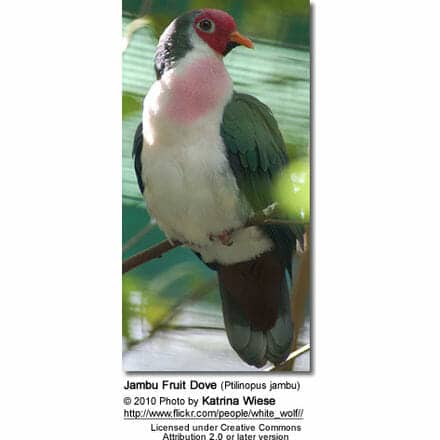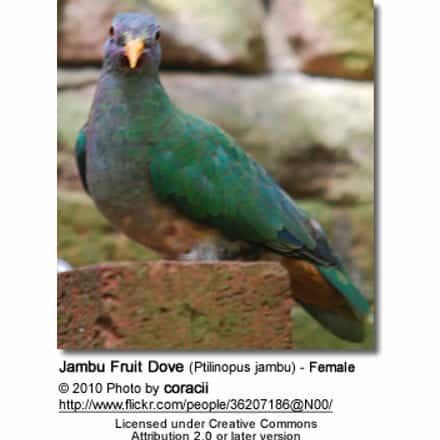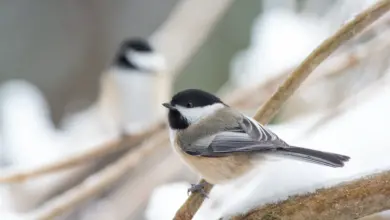Jambu Fruit Doves
The Jambu Fruit Dove, Ptilinopus jambu, is a smallish colorful fruit-dove.
Distribution / Range
It is a resident breeding species in southern Thailand, Malaysia, Brunei and the Indonesian islands of Kalimantan, Sumatra and Java.
The Jambu Fruit Dove inhabits mangrove swamps and lowland rain forests up to 1,500 m and is also found in second growth woodland.
Description
The Jambu Fruit Dove is 23–27 cm long and weighs about 42 g. It is a plump small-headed bird with soft feathers and very distinctive colouring including a white eye ring, orange bill and red legs. The call is a soft, low coo.

The adult male has a crimson face with a black chin, unmarked green upperparts and white underparts, with a pink patch on the breast and a chocolate brown undertail. The female differs from the male in that she has a dull purple face with a dark chin. The underparts are green with a white belly and cinnamon undertail.
The immature Jambu Fruit Dove resembles the female but has a green face. Immature males look a lot like the female. The young male acquires its full adult plumage in about 39 weeks from fledging.


Breeding / Nesting
The male holds a breeding territory, advertised by raising its wings, bobbing its body and cooing. It will defend its territory with a quick peck if the territorial display fails.
The female builds a flimsy nest of twigs, roots and grasses, which are collected by her mate, in a tree and lays one or sometimes two white eggs which are incubated for about 20 days to hatching, with a further 12 or more days to fledging.
Further Dove Information
- Dove Information
- Index of Dove Species
- Photos of the Different Dove Species for Identification
- Doves & Pigeons as Pets
Diet / Feeding
The Jambu Fruit Doves is a shy and inconspicuous bird, camouflaged against the forest canopy by its green plumage. It is usually seen alone or in pairs, but a sizable flock may gather when feeding at a fruit tree. It eats fruit directly from the tree, or from the ground if items have been dropped by hornbills or monkeys.
Like other doves, but unlike most birds, it can drink by sucking.
Status
Extensive deforestation in Indonesia and Malaysia means that this dove is now threatened, although its ability to live in second growth and at higher elevation means that its situation is not as critical as that of some forest bird species.
The Jambu Fruit Dove is evaluated as Near Threatened on the IUCN Red List of Threatened Species.

References
- BirdLife International (2004). Ptilinopus jambu. 2006. IUCN Red List of Threatened Species. IUCN 2006. Retrieved on 11 May 2006. Database entry includes a brief justification of why this species is near threatened
- King, Woodcock and Dickinson, Birds of South-East Asia, ISBN 0-00-219206-3




